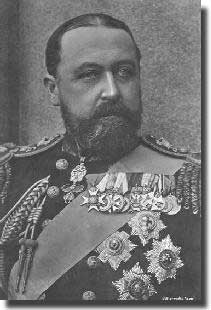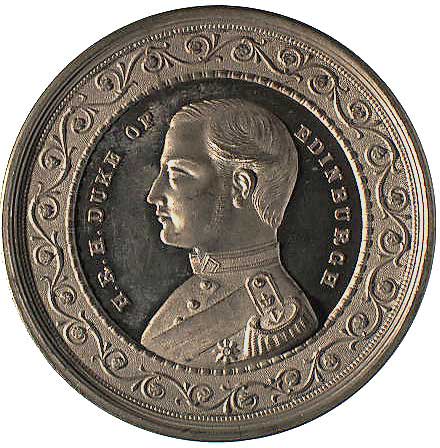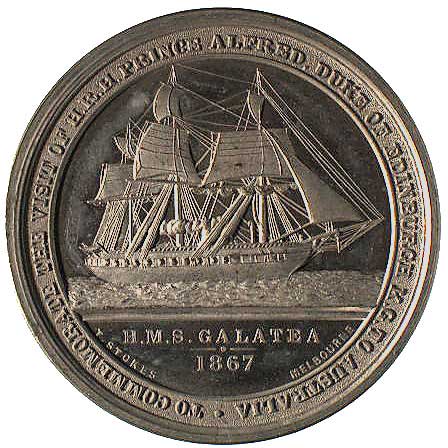Introduction.
Prince Alfred, the 4th. child of Queen Victoria, had joined the Royal Navy as a Midshipman back in 1858. He progressed through the ranks, and in 1866 was given command of the frigate HMS Galatea, to depart on a world tour in January of 1867. He was to visit Australia, to be the first member of the Royal family to arrive in, and tour the colony.

HMS Galatea arrives off Sydney Heads
Early life.
Born at Windsor Castle on the 6th. of August 1844, the second son of Queen Victoria, his father, Prince Albert of Saxe-Coburg-Gotha, the young prince, had been christened Alfred Alexander William Ernest Albert by the then Archbishop of Canterbury, William Howley, in the Private Chapel of Windsor Castle on the 6th. of September 1844.
Having decided to join the Royal Navy, in 1856, Prince Alfred passed his examination for Midshipman, to be appointed to HMS Euryalus.
Royal Navy and Birthday Honours.
Promoted to Lieutenant on the 24th. of February 1863, by February of 1866 he had made Captain, and was given command of the wooden steam Frigate HMS Galatea. Created the Duke of Edinburgh, and Earl of Ulster and of Kent in the Queen's Birthday Honours of May in 1866.

HRH Duke of Edinburgh ( 1844-1900) in the uniform of an Admiral, Royal Navy
World Tour.
In Galatea, he left Plymouth on the 24th. of January 1867 on a world voyage. First to Gibraltar, thence the Cape of Good Hope, and off across the vast Indian Ocean to Australia for the first ever Royal Tour of that continent, landing at Glenelg, South Australia on the 31st. of October.
This tour was to last for five months, visiting Adelaide, Melbourne, Sydney, Brisbane, and Tasmania. In Victoria, a special Royal train was made up for the occasion, and the Duke travelled in it to provincial towns such as Bendigo, Geelong, and Ballarat.
Attacked by Henry James O'Farrell.
On the 12th. of March 1868, whilst visiting Sydney for the second time, the Duke was on the beach front of Clontarf, enjoying an Australian type picnic when he was attacked by an Irishman, Henry James O'Farrell flourishing a revolver, to be shot in his back to the right of his spine.
O'Farrell first claimed that he had acted on instructions from a band of Melbourne Fenians, but later retracted and stated that " From continually thinking and talking of the wrongs of Ireland , I became excited and filled with enthusiasm for the subject, and it was then under the influence of those feelings that I attempted to perpetrate the deed for which I am now justly called upon to suffer ." Found guilty of attempted murder O'Farrell was hanged at Darlinghurst gaol on 21 April and buried in the Catholic section of Rookwood cemetery.
The Duke was tended by six Florence Nightingale trained nurses led by Matron Lucy Osburn, not long arrived in the Colony.

O'Farrell who shot the Duke of Edinburgh in the back.
The Irishman was later hanged for attempted murder
Public Conscription.
Influencial citizens of Sydney met on the evening of the 23rd. of March 1868, to vote for a Memorial to be built " To raise a permament and substantial monument in testimony of the heartfelt gratitude of the Community at the recovey of HRH."
The result led to a public conscription which paid for the Royal Prince Alfred Hospital's construction.
Comment.
Oh! how times have changed in Australia, whilst the present Monarchy is well respected, talk of becoming a Republic is abroad.
Minting of Commemorative Medal by Thomas Stokes of Melbourne.
Thomas Stokes, a badge and medal producing company in Melbourne, manufactured a Commemorative Medal to be sold throughout Australia to mark the Duke Of Edinburgh's visit.

Obverse - Bust of the Duke facing left, around it is the inscription H.R.H. THE DUKE OF EDINBURGH.

Reverse - The Duke's ship HMS Galatea under sail and steam, below which is H.M.S. GALATEA 1867. Around it on a broad border is the legend TO COMMEMORATE THE VISIT OF H.R.H. PRINCE ALFRED, DUKE OF EDINBURGH, K.G. TO AUSTRALIA. The maker's name, T.STOKES MELBOURNE, can be seen in small letters below the date.
This company still operates in Melbourne today, when I worked at Austin Hospital in the 1970's, a Melbourne teaching hospital at Heidelberg, the Chairman of the Board of Management was Harold Stokes, also Managing Director of Stokes and Company Pty. Ltd. the same company that made the Duke' s Medal, so long ago in 1867, they still produce badges, trophies etc today.

Royal Standard of England
The Duke visits Queensland.
In 1868, the western railway line reached Jondaryan in Queensland. His Royal Highness Prince Alfred, the Duke of Edinburgh, was on a visit to Australia. When visiting Queensland, he was taken to Jondaryan to open the new extension to the railway line, which was one of the greatest achievements of the government of the time.
The visit was a disaster right from the start.
The special train carrying the Prince and his retinue of dignitaries ran hours late, arriving at Jondaryan after dark, throwing all the arrangements out for the official welcome and opening celebrations.
The following is an extract taken from the writings of the Reverend John Milner, who accompanied Prince Alfred on his Australian tour.
"Because of the lateness of the arrival of the train, all the welcoming arrangements had to be reorganised, causing some two hours further delay.
"The Duke was confined to a small room at the railway station with his attending staff, while the squatters and other gentlemen who had assembled to welcome the Duke, took possession of the vacant carriages and settled down to their pipes and conversation, it being unclear what the next move was to be.
"The Duke was highly amused by the oddness of the whole affair and asked, 'What came we out to see?'"
The Commodore went to see what was going on and found that preparations were being made for a dinner, as it was so late.
About 10 o'clock in the evening dinner was announced by which time everyone was afflicted with considerable hunger pains. Some 50 guests sat down with the Duke's party in a large tent decorated with flags and flowers.
After the Governor had made the Royal toast, the manager of Jondaryan station Mr Graham, made a very amusing speech, presenting the Duke with a very large damper that had been especially made on the station for him, as a gift from the station people.
The Duke in accepting the damper, said that he could not possibly eat it all himself and received it as eaten.
At this point another gentleman proposed the health of His Excellency, the acting Governor. He took the opportunity of saying how desirous the squatters were that he should be confirmed in the appointment, appealing to the Duke to use his influence with the Queen for that purpose.
At that point a voice desired him to sit down, but this request made him persevere the more, as he saw that the majority was definitely with him.
After the dinner was concluded, Mr Graham invited the Duke and his party to accompany him to the Jondaryan homestead, some two miles distant, where he offered to put the party up for the night.
However, an over-zealous government official insisted that the Duke should spend the night in the accommodation that had been arranged for him at the railway station.
So the remainder of the Duke's party departed with Mr Graham for Jondaryan, leaving the Duke to the enjoyment of his dreary quarters.
The following morning, Mr Graham invited the Duke and his party to spend the day hunting, as there were plenty of kangaroos, emus and plain turkeys to be had on the Downs.
The Duke being a keen sportsman, expressed his delight at the invitation, adding that it would help to loosen up his cramped muscles from the past night's sleep.
However, the official organising the tour said the Duke's schedule could not allow him the time to do that, as so much time had been lost on the previous day.
Prince Alfred was not impressed with his visit to Jondaryan, for on his return to England, he is reported as having told his mother Queen Victoria, "In New South Wales they shot at me, in Victoria they mobbed me, but in Queensland they sent me to Jondaryan and inflicted me with over zealous officials."
Acknowledgement.
This essay was written by John Eggleston, the Jondaryan Woolshed Historical Museum and Park Association's Historical Research Officer.
The Duke departs Australia.
HMS Galatea left for home in April of 1868 via New Zealand, the first time Royalty had visited that country, to arrive at Spithead on the 26th. of June that year after an absence of 17 months.

#3051 Group of Tahitian women (royalty) with Prince Alfred, Duke of Edinburgh & Saxe Coburg Gotha (1844-1900), and other European men. Carte-de-visite photograph, 1870 100 x 64 mm Photographer unknown HRH Prince Alfred (son of Queen Victoria of England) visited Tahiti in 1870. He is seated on a chair at centre. The woman resting on his knee is Mlle. Brander (Titana) (cf Chamonal, Early Inhabitants In Oceania, no. 72 reproduced back cover). Good condition but with small section of surface lifting, left hand edge, due to tiny puncture on reverse.
I am indebted to this web site Oceania Ethnographica for this copy of an old photograph from 1870.
Marriage.
On the 23rd. of January 1874, the Duke of Edinburgh married Her Imperial Highness, Grand Duchess Marie Alexandrovna of Russia, second daughterof the Tsar Alexander11. and Marie of Hesse and by Rhine.
The couple had six children, namely: Prince Alfred ( Young Affie ), Princess Marie, Princess Victoria Melite, Princess Alexandra, an unnamed still born child, and Princess Beatrice.
Flag Rank.
Alfred remained an active Naval Officer, he was promoted to Rear Admiral on the 30th. of December 1878, Vice Admiral on the 10th. of November 1882, Admiral on the 18th. of October 1887, and to the top of the Naval ladder, Admiral of the Fleet, on the 3rd. of June 1893.
Duchy of Saxe-Coburg-Gotha.
When the Duke's uncle Ernst11 died in August 1873, he acceded to the Duchy of Saxe-Coburg-Gotha, at first, regarded with a degree of coldness as a foreigner, but by the time of his death from throat cancer in 1900, he had essentially won over his subjects.

House of Saxe- Coburg and Gotha
Death of only son Alfred.
The hereditary Prince Alfred was involved in a scandal about his mistress and shot himself in January of 1889, during his parents 25th. wedding anniversary celebrations, not very good timing.
He survived to be banished to Meran to recover, but died just two weeks later on the 6th. of February.
Duke dies.
As indicated earlier, the Duke was claimed by throat cancer on the 30th. of July 1900, to be buried in the family Ducal cemetery outside of Coburg.
His nephew Prince Charles succeeded him.
Conclusion.
Alfred, Duke of Edinburgh, as the first Royal visitor to Australia did make a good impression in the Colony. He was an efficient and successful Naval Officer in the Royal Navy, rising to its top rank as Admiral of the Fleet.
His final legacy was to have the main settlement of Tristan de Cunha, Edinburgh of the Seven Seas, named after him, he had visited the remote islands in 1867 as part of his world tour in HMS Galatea.








